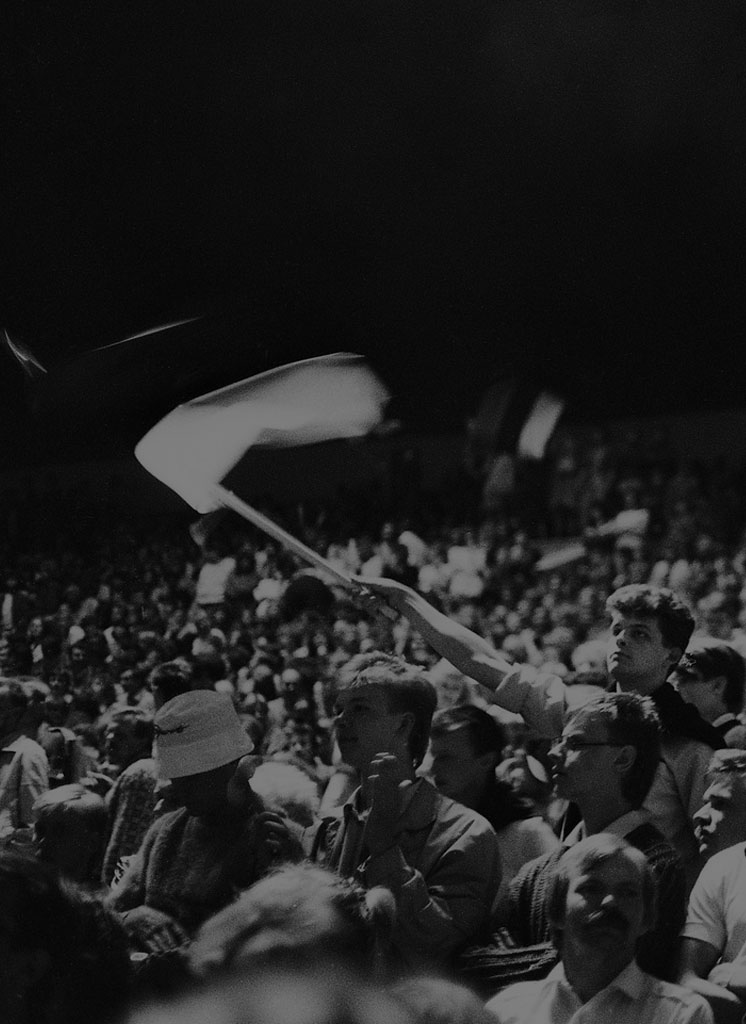
SLS’s involvement in the political processes regarding the maintenance of continuity of Latvian statehood, in the processes of the Singing Revolution.
In Australia, support groups for the work of Helsinki 86 were formed, with donations making their way through complex channels to their recipients. In January 1988, invited by Daugavas Vanagi, Rolands Silaraups, whom everyone got to know from the march at the Freedom Monument on 14 June 1987, visited Australia.
The Latvian community in Australia became increasingly politically active, paying special attention to commemorative days of importance to the Latvian people.
During the years of Latvia’s Third Awakening, Latvian Popular Front support groups were established in major Australian cities. Sydney was home to one of the Latvian National Front support groups in Australia. All Latvian organisations in the city were involved in Latvia’s relief efforts. As Dainis Īvāns later wrote, “The heart and soul of the Sydney supporters were Ausma Medne and her family, the Bērziņš family, the Andersons family and countless other patriotic Latvians.”
During the Baltic Way, the Australian Balts organised support actions. Humanitarian aid was sent to Latvia.
At the end of 1989, a symposium organised by the Baltic Council of Australia was held in Sydney, attended by five Baltic politicians, including Dainis Īvāns and Elmārs Vēbers.
On 22 November 1989, in Canberra, Australian Prime Minister Robert J. L. Hawke received the leaders of the Estonian, Latvian and Lithuanian “informal organisations” – Tunnis Kelam of the Estonian National Independence Party, Dainis Īvāns, Chairman of the LPF, and Kazimir Antanavičius of Lithuania’s Sajūdis. When D. Īvāns was in Australia to visit the major Latvian centres there and to give the 18 November celebration speeches. The Australian chapter (Melbourne) of the Latvian Popular Front managed to arrange an hour-long meeting between the LPF leader and the Australian Prime Minister. Mr Hawke became the first head of government of a Western country to meet the leader of the LPF.
The possibility of sending books to Latvia was discussed with Dainis Īvāns. The first shipment left Melbourne at the end of 1991.
Most Latvians in Australia had high hopes for the Latvian Popular Front. An important line of action was to persistently inform and remind the Australian government about the situation in Latvia. An important role was played by broadcasts in Latvian (SBS Radio, 2EA in Sydney and SBS Radio, 3EA in Melbourne) broadcasts in Latvian, which in the late 1980s and throughout the 1990s provided news about the events of the Third Awakening in Latvia, revolutions and developments in Eastern European countries, as well as later developments in Latvia. During the Awakening years, Australian Latvians managed to get a lot of relatively broad coverage of the Baltic in the Australian press. At critical moments for Latvia, they organised spectacular demonstrations, which were also attended by Australian politicians.
The Australian branch of LPF supported several goals important to Latvia, such as the Olympic Committee, the organization “Save the Children!”.
Compatriots provided various types of assistance to the Popular Front in Latvia, including monetary donations and humanitarian aid.
Australian LPF support groups also had a busy period of activity in January 1991, during the coup and barricades in Latvia. Thanks also to the political activity of the Baltic Council of Australia, the Australian Latvian community and the Honorary Consul of the Republic of Latvia in Melbourne, Emīls Dēliņš, Australia was one of the first countries to recognise the restoration of Latvia’s independence (August 27, 1991).